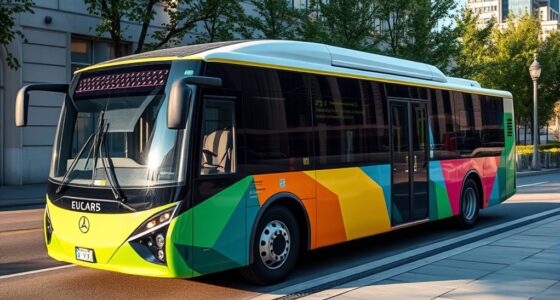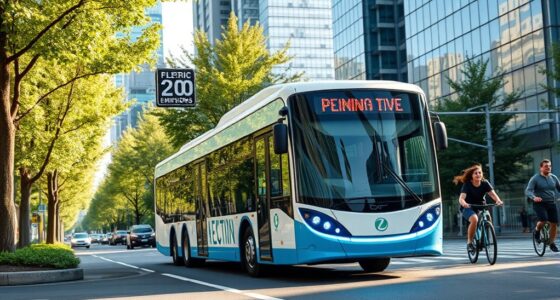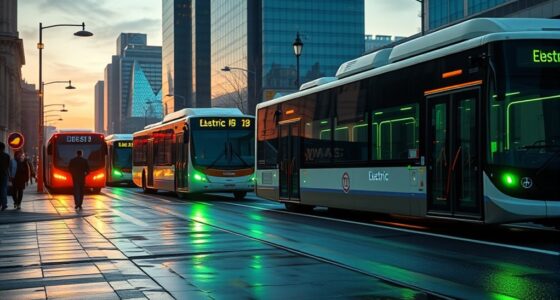Electric buses help you meet climate goals by markedly cutting greenhouse gas emissions, especially as more clean energy sources power the grid. They improve urban air quality by reducing harmful pollutants, which benefits public health. Their efficiency and decreasing costs make sustainable transportation affordable. Advances in battery and charging tech boost reliability, while policies and infrastructure support accelerate adoption. Staying informed on these innovations shows how electric buses can drive sustainable change in your community.
Key Takeaways
- Electric buses reduce greenhouse gas emissions, especially as electricity grids become cleaner with renewable sources.
- They improve urban air quality by eliminating pollutants from diesel exhaust, supporting healthier cities.
- Adoption of electric buses helps cities meet climate targets by decreasing transportation-related carbon footprints.
- Advanced battery and charging technologies enable longer ranges and faster charging, increasing operational efficiency.
- Supporting policies and infrastructure development accelerate electric bus deployment, enhancing overall climate and sustainability efforts.
Reducing Greenhouse Gas Emissions
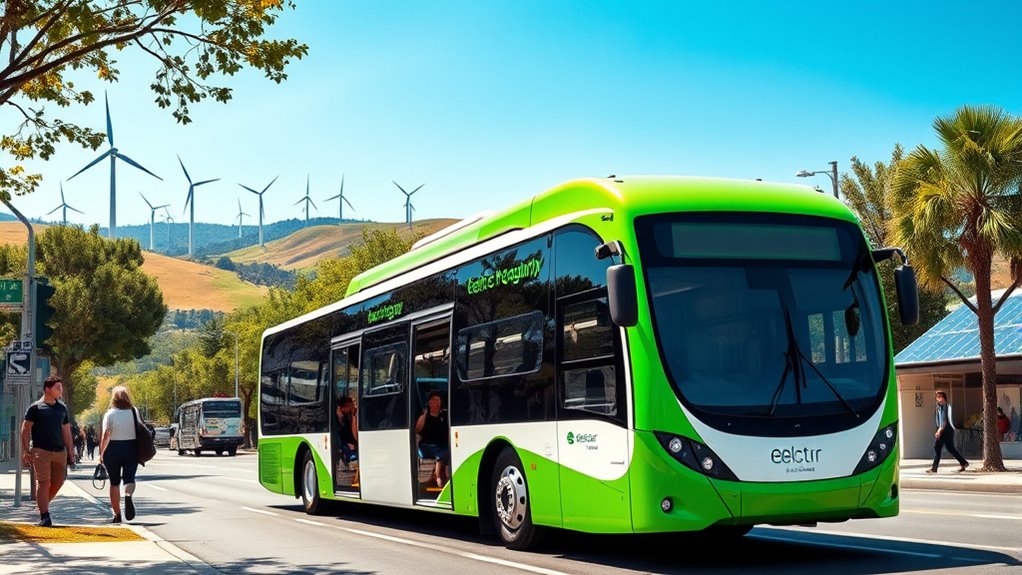
How much can electric buses actually reduce greenhouse gas emissions compared to traditional diesel buses? Electric buses generally produce lower lifecycle emissions, especially as the electricity grid shifts to cleaner sources. They’re more energy-efficient, converting 77 to 100% of grid energy into vehicle motion, unlike internal combustion engines. If powered by renewable energy, electric buses can cut emissions by up to 96% compared to diesel models. As the grid becomes greener over time, emissions from electric buses will drop further. Renewable energy sources play a crucial role in maximizing emission reductions from electric buses, including innovations in energy storage and grid integration. Additionally, advances in energy storage technology can help smooth out supply fluctuations and further enhance the environmental benefits of electric transit. Incorporating smart grid systems can optimize energy use and improve overall efficiency. Replacing all diesel transit buses with electric ones could eliminate over 2 million tons of greenhouse gases each year. This shift supports long-term climate goals by reducing the carbon footprint of public transportation and leveraging technological advancements and policy support for cleaner energy sources.
Improving Urban Air Quality

Electric buses play an essential role in improving urban air quality by markedly reducing harmful emissions in cities. They cut urban pollution by lowering nitrogen oxides and particulate matter, which are major contributors to smog and health problems. Wall organization systems can also support efforts to create cleaner environments by helping to manage urban space efficiently. Soot-free technologies in electric buses help combat these emissions, creating cleaner, healthier environments. Cities that adopt electric buses often see notable declines in air pollution-related health issues, benefiting residents’ wellbeing. This shift supports broader efforts to improve public health and meet environmental goals. By reducing airborne pollutants, electric buses foster healthier urban spaces, making daily life safer for those who rely on public transportation. AI security solutions are increasingly vital in managing and protecting the data associated with these transportation systems, ensuring their safe and effective operation. Their deployment is a critical step toward cleaner air and a more sustainable, livable city. Implementing electric bus fleets can further accelerate progress toward these environmental and health benefits. Additionally, integrating sustainable transportation initiatives can amplify the positive impact on urban air quality and climate goals.
Achieving Cost-Effective Transportation

Switching to electric buses can considerably improve transportation cost-efficiency by reducing long-term expenses, even if the initial investment appears higher.
While electric buses cost between $350,000 and $887,308 compared to $480,000 for diesel buses, you save about $50,000 annually on fuel and maintenance. Charging infrastructure adds $10K–$30K per bus but is offset by fuel and repair savings over the vehicle’s lifespan, which can reach $400,000 in fuel and $125,000 in maintenance per bus. Additionally, sulfate-free options in maintenance products can prolong vehicle lifespan and reduce damage to sensitive components. Utilizing cost-effective maintenance strategies can further enhance the overall savings and sustainability of electric bus fleets.
The typical payback period is around five years. Plus, electric buses have simpler drivetrains with fewer moving parts, reducing maintenance costs, downtime, and repair needs.
These savings, combined with government incentives and more stable energy prices, make electric buses a cost-effective choice for sustainable transportation.
Advancing Battery and Charging Technologies
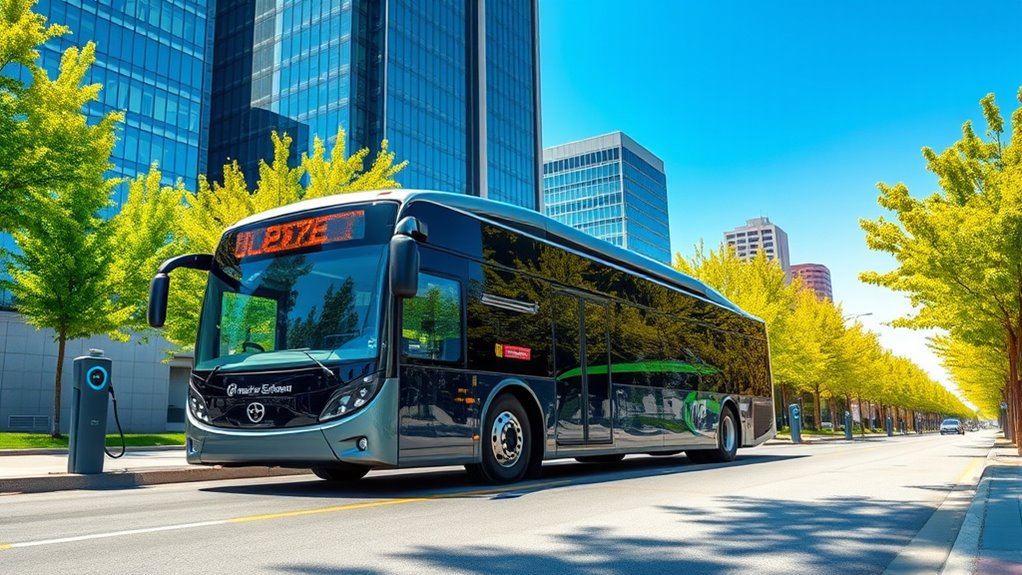
Recent advancements in battery and charging technologies are transforming electric bus operations by increasing range, safety, and efficiency. Higher energy density batteries now let you travel over 250 miles on a single charge, reducing downtime and increasing route flexibility.
Recent battery and charging tech boost electric bus range, safety, and efficiency.
Solid-state batteries enhance safety by minimizing thermal risks and leaks, while lithium-sulfur batteries offer longer lifespan and better energy storage. Fast charging systems and high-power chargers, like those from ABB and Siemens, cut charging times and boost operational efficiency.
Wireless charging and AI-optimized systems further streamline energy management, reducing costs and downtime. Next-generation anodes, solid electrolytes, and lightweight materials improve performance and durability.
These innovations not only extend bus range but also make charging safer and faster, supporting more sustainable, reliable transit solutions.
Promoting Public Health and Well-being
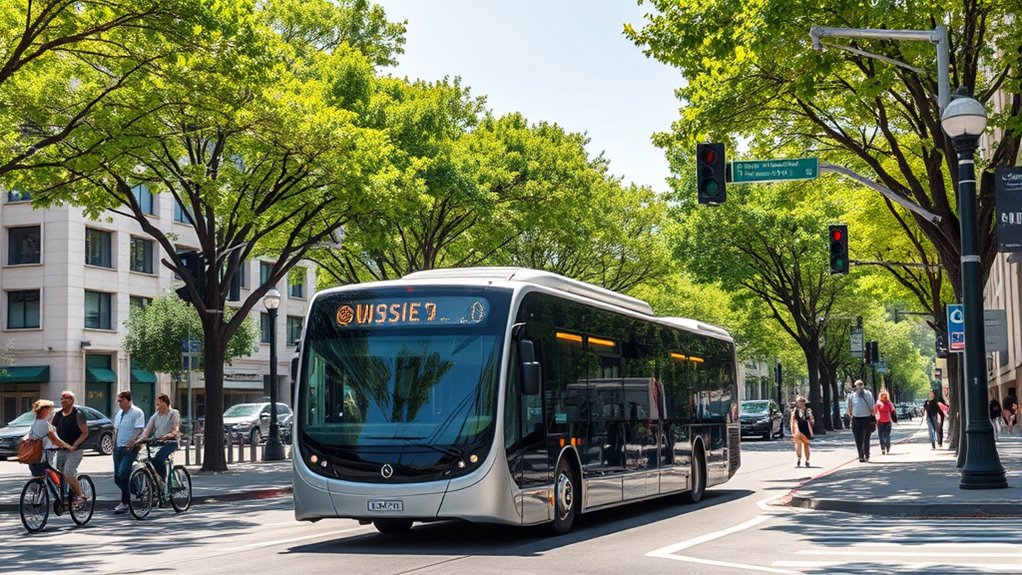
Advancements in battery and charging technologies are making electric buses more reliable and efficient, which directly benefits public health. By eliminating diesel exhaust, electric buses reduce harmful pollutants like particulate matter and ground-level ozone precursors. This cleaner air improves overall community health, especially in urban areas where diesel emissions are concentrated.
Reduced exposure to PM 2.5 lowers the risk of respiratory diseases, including asthma, and can decrease premature deaths. Children and vulnerable populations benefit the most, with fewer new asthma cases and better lifelong health outcomes. Additionally, the use of advanced filtration technology in electric buses can further enhance air quality by capturing residual pollutants, ensuring cleaner breaths for passengers and residents alike.
Communities affected by high pollution levels—often low-income and minority populations—see significant health improvements. Furthermore, air quality measures are essential for assessing the effectiveness of these cleaner transportation options. Incorporating protective styling benefits from various anti-pollution strategies can also contribute to reducing exposure to airborne toxins. Overall, electric buses contribute to healthier environments, reducing disease incidence and enhancing quality of life for residents.
Supporting Policy and Infrastructure Development

Supporting policy and infrastructure development is essential to accelerating the adoption of electric buses and achieving climate goals. You’ll see governments enforcing strict emission standards and offering incentives like funding and low-interest loans, making electric buses more affordable.
Supporting policies and infrastructure are key to boosting electric bus adoption and meeting climate targets.
Policies set emission reduction targets aligned with international climate commitments, while collaboration among government agencies, private companies, and communities ensures effective implementation. A clear regulatory framework helps guide the transition and provides certainty for investments. Additionally, ongoing public awareness campaigns can motivate communities and stakeholders to support electric bus initiatives.
Legislative actions, such as the Advanced Clean Trucks Rule, help facilitate fleet transitions. Infrastructure development, including charging stations and grid assessments, is crucial for smooth operation. Strategic planning and coordinated efforts between agencies enhance the efficiency of infrastructure deployment and ensure it meets future demand.
Public-private partnerships and government funding speed up infrastructure growth, while technological innovations like fast charging and overhead systems improve efficiency.
Effective planning and coordination are vital to ensure that infrastructure development meets the growing demand for electric buses. Integrating innovative grid management solutions can further optimize energy use and support sustainable growth.
These combined efforts create a supportive environment that encourages adoption, reduces emissions, and advances climate objectives.
Frequently Asked Questions
How Do Electric Buses Impact Local Ecosystems Beyond Air Quality?
You might wonder how electric buses affect local ecosystems beyond improving air quality. They tend to have a smaller environmental footprint since they produce no tailpipe emissions that harm plants and animals.
Additionally, electric buses generate less noise pollution, which benefits wildlife and urban habitats. As you adopt electric buses, you’re helping to preserve natural habitats and reduce disturbances, creating a healthier, more balanced environment for ecosystems around your community.
What Challenges Exist for Integrating Electric Buses Into Existing Transit Systems?
Picture trying to fit a new puzzle piece into an existing picture—you must navigate tricky edges and missing pieces.
For electric buses, you face challenges like limited charging stations, requiring careful planning.
Upgrading the grid and training staff feels like rebuilding a bridge while buses still run.
High costs and complex logistics can slow the process, but with strategic effort, you can smoothly integrate electric buses into your transit system.
How Do Electric Buses Perform in Extreme Weather Conditions?
You’ll find electric buses perform well even in extreme weather, thanks to their design and operational strategies.
In cold conditions, range drops about 33%, but preconditioning your batteries while plugged in helps uphold efficiency. Their weight distribution enhances traction on icy roads, and faster cabin heating improves passenger comfort.
With proper route planning and driver training, you can guarantee reliable operation, making electric buses a resilient choice regardless of weather challenges.
What Are the Lifecycle Environmental Impacts of Electric Bus Batteries?
You should consider that electric bus batteries have notable lifecycle impacts. Their production demands significant mining of materials like lithium, cobalt, and nickel, which harms the environment.
During use, they emit no tailpipe pollutants, especially when charged with renewable energy. However, larger batteries and shorter lifespans increase environmental burdens.
Recycling and second-life applications help reduce resource extraction and waste, but current processes vary in efficiency, impacting overall sustainability.
How Can Communities Ensure Equitable Access to Electric Bus Benefits?
You can guarantee equitable access to electric bus benefits by actively involving community members in planning and decision-making. Prioritize funding for underserved neighborhoods, especially those with high pollution exposure.
Partner with local organizations, adopt transparent processes, and include community feedback. Focus on replacing high-emission buses, providing workforce training for local residents, and supporting minority-owned contractors.
These actions help address systemic barriers and ensure everyone benefits from cleaner, healthier transportation options.
Conclusion
By embracing electric buses, you can play a crucial role in reducing emissions and improving your city’s air quality. These vehicles offer cost-effective options while advancing new battery tech and supporting healthier communities. Remember, the road to a sustainable future isn’t a sprint, but a journey you’re actively shaping. Staying informed and engaged helps guarantee that your efforts pay off, proving that when everyone pulls together, the sky’s the limit for a greener, cleaner world.


